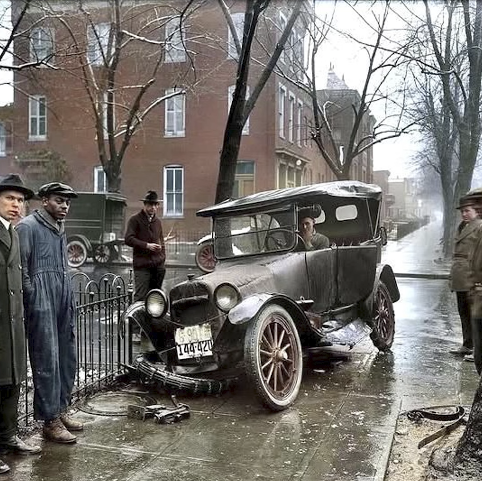
In the early 1920s, the automobile was both a marvel and a menace. Cities like Washington, D.C., were just beginning to adapt to the rise of motorized vehicles. The streets—still lined with cobblestones, trolley tracks, and horse-drawn carriages—were not yet designed for speed.
This photograph, taken in 1921, captures a scene that was becoming increasingly familiar: a car accident. But unlike today, when such moments are often rushed past, accidents in the 1920s drew crowds. People would stop whatever they were doing—step outside shops, lean over fences, gather on sidewalks—to witness the mechanical drama of a new era.
The car, likely a touring model from the 1910s or early ’20s, lies half-crumpled against the curb. Its wooden-spoked wheels are damaged, the headlamps bent. The driver, still in the seat, seems dazed but unharmed. Around him stand men in newsboy caps and heavy coats, their faces a mix of curiosity, concern, and disbelief.
For many of them, this may have been their first close look at an automobile accident. Just a decade earlier, such a sight would have been almost unthinkable.
A Society Learning New Rules
At the dawn of the 20th century, traffic laws barely existed. There were no seatbelts, no speed limits, and no driver’s licenses in most cities. Pedestrians, carriages, and early cars all shared the same chaotic roads. Washington, D.C., was one of the first cities to experiment with stop signs—but in 1921, even those were rare.
Accidents like this one were often reported in local newspapers as cautionary tales. They were described not just as mishaps but as symbols of change—reminders that progress always carried risk.
The men in the photo wear the era’s working-class attire: overalls, wool coats, and caps, with one man in a fedora likely a passerby or small business owner. Their body language says it all—they’re not just gawking; they’re witnessing history unfold in front of them.
Breathing Color Into History
The image was originally shot in black and white, as all photos of that time were. But modern artist Sanna Dullawa carefully colorized it, breathing warmth and life back into the frozen moment. The red-brown bricks of D.C. rowhouses, the muted blue of the men’s coats, and the damp gray of the pavement now feel tangible—almost cinematic.
Her work doesn’t just add pigment—it restores emotion. The cold, misty air of that morning seems to cling to the scene. You can almost hear the murmurs of the crowd, the creak of leather seats, the distant hum of a city learning to move faster than ever before.
A Mirror of Change
This photo, simple at first glance, captures more than a car accident. It captures a turning point—the moment when humanity began learning how to coexist with machines.
Each onlooker stands for a different stage of that change: fascination, fear, acceptance. The broken car isn’t just a wreck—it’s a symbol of a nation transitioning from horse hooves to engines, from slow rhythms to roaring progress.
Looking back now, a century later, it’s hard not to feel a strange kinship with those men on the sidewalk. They were witnessing the birth of modern life—messy, loud, and unstoppable.
One accident. One photograph. A century of progress captured in a single frame.
🚗 If this glimpse into history moved you, share it. Because every old photograph is a story still waiting to be heard.